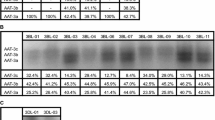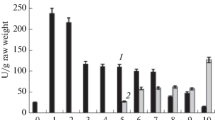Abstract
Electrophoretic patterns of malate dehydrogenase (Mdh), alcohol dehydrogenase (Adh), and 6-phosphogluconate dehydrogenase (Pgd) of Zea mays L. × Tripsacum dactyloides L. hybrids and their parents were compared. The components of enzymes specific to T. dactyloides may be used as markers to identify the following T. dactyloides chromosomes in the hybrids: Tr 16 (Mdh 2 and Pdg 1), Tr 7, and/or Tr 13 (Adh 2). The isozymes of Mdh 2 are supposed as a possible biochemical marker to evaluate the introgression of genes, determining an apomictic mode of reproduction from T. dactyloides (localized on Tripsacum 16 chromosome) into Z. mays. The isozymes may be used as markers for the identification of maize chromosomes 1 and 6 in the hybrids as well. Chromosome count taken on the examined hybrids showed the addition of 9 to 13 chromosomes of T. dactyloides to maize chromosome complement.
Similar content being viewed by others
References
Bednář, J., Provazniková, E.: [Polymorphism of enzymes as genetic markers in breeding of maize hybrids.]-Genet. Šlecht. (Praha) 30: 305–312, 1994. [In Czech.]
Berquist, R.: Transfer from Tripsacum dactyloides to corn of major gene locus conditioning resistance to Puccinia sorghi.-Phytopathology 71: 518–520, 1981.
Berthaud, I., Savidan, Y.: Genetic resources of Tripsacum and gene transfer to maize.-In: Mujeeb-Kazi, A., Sitch, L.A. (ed.): II International Symposium on Genetic Manipulation in Crops. Pp. 121–130. International Maize and Wheat Improvement Center, Mexico-Manila 1989.
Burns, J., Fisher, D., Pond, K., Timothy, D.: Diet characteristics, digesta, kinetics, and dry matter intake of steer grazing eastern gamagrass.-J. anim. Sci. 70: 1251–1261, 1992.
Burson, B., Voigt, P., Sherman, R., Dewald, C.: Apomixis and sexuality in eastern gamagrass.-Crop Sci. 30: 86–89, 1990.
Davis, B.: Disc electrophoresis. II. Method and application to human serum proteins.-Ann. N. Y. Acad. Sci. 121: 404–427, 1964.
Galinat, W.: Intergenomic mapping of maize, teosinte and Tripsacum.-Evolution 27: 644–655, 1973.
Goodman, M., Stuber, C., Lee, C., Johnson, F.: Genetic control of malate dehydrogenase isozymes in maize.-Genetics 94: 153–168, 1980a.
Goodman, M., Stuber, C., Newton, K., Weissinger, H.: Linkage relationships of 19 enzyme loci in maize.-Genetics 96: 697–710, 1980b.
Kato-Noguchi, H.: Osmotic stress increases alcohol dehydrogenase activity in maize seedling.-Biol. Plant. 43: 621–624, 2000.
Kindiger, B., Bai, D., Sokolov, V.: Assignment of gene(s) conferring apomixis in Tripsacum to a chromosome arm: cytological and molecular evidence.-Genome 39: 1133–1141, 1996.
Kindiger, B., Becket, J.: Popcorn germplasm as a parential source for maize × Tripsacum dactyloides hybridization.-Maydica 37: 245–249, 1992.
Kindiger, B., Vierlig, R.: Comparative isozyme polymorphism of North American eastern gamagrass, Tripsacum dactyloides var. dactyloides and maize, Zea mays L.-Genetica 94: 77–83, 1994.
Koltunow, A., Bickuel, R., Chandhyry, A.: Apomixis: molecular strategies for generation of genetically identical seeds without fertilization.-Plant Physiol. 108: 1345–1352, 1995.
Leblanc, O., Grimanelli, D., Gonsalez de Leon, D, Savidan, Y.: Detection of the apomictic mode of reproduction in maize — Tripsacum hybrids using maize RFLP markers.-Theor. appl. Genet. 90: 1198–1203, 1995.
Rychter, A., Levak, S.: Polyacrylamide gel electrophoresis of apple seed enzymes.-Acta biochem. pol. 16: 332–338, 1969.
Schwartz, D.: Genetic control of alcohol dehydrogenase. A competition model for regulation of gene action.-Genetics 67: 411–425, 1971.
Shaw, C.R., Prasad, R.: Starch gel electrophoresis of enzymes — a compilation of recipes.-Biochem. Genet. 4: 297–320, 1970.
Sukhorzhevskaya, T., Khavkin, E.: Isozymes of 6-phosphogluconate dehydrogenase (6 PGD): a presumable mode of control.-Maize Genet. Coop. News Lett. 55: 46–47, 1980.
Tsanev, V., Todorova, L., Rocheva, S.: Composition of esterase and peroxidase isoenzyme complex, zein-2 protein fraction, and SDS-protein complex of Zea mays L. × Tripsacum dactyloides L. hybrids and parents.-Biol. Plant. 43: 211–215, 2000.
Vladova, R.: Slower moving to the anode malate dehydrogenase isozymes of rye, wheat and Triticale seeds.-Biochem. Physiol. Pflanz. 187: 409–416, 1991.
Vladova, R., Petkolicheva, K.: Use of isozymes and seed storage proteins as chromosome markers in the study of tetraploid Triticales.-Cereal Res. Commun. 24: 417–424, 1996.
Weisinger, H., Stuber, C., Goodman, M.: Linkage relationships between isozyme loci in maize.-Genetics 91(Suppl.): 136, 1979.
Zlokolica, M., Milošević, M.: Isozymes as genetic markers in maize breeding.-Biol. Plant. 44: 207–211, 2001.
Author information
Authors and Affiliations
Rights and permissions
About this article
Cite this article
Tsanev, V., Vladova, R., Petkolicheva, K. et al. Malate Dehydrogenase, Alcohol Dehydrogenase, and 6-Phosphogluconate Dehydrogenase Isozymes of Zea mays L. × Tripsacum dactyloides L. Hybrids and Parents. Biologia Plantarum 45, 517–522 (2002). https://doi.org/10.1023/A:1022312806492
Issue Date:
DOI: https://doi.org/10.1023/A:1022312806492




